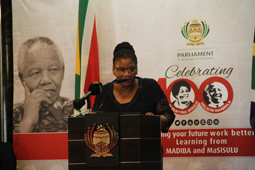
Our unveiling today of these inscriptions of our Constitution’s principles pays tribute to two significant events.
One is the births, in 1918, of two exemplary South Africans, who courageously fought and sacrificed family life for the democracy we now enjoy.
Today, we again pay homage to their immense contributions to establishing our democracy – which we must safeguard.
I speak of Mr Nelson Rolihlahla Mandela, the first President of our democracy, and Ms Albertina Nontsikilelo Sisulu, that self-effacing champion for freedom and Member of our first democratic Parliament who nominated Madiba for President.
The world joined us in celebrating their centenary birthdays.
The inscriptions also commemorate the 25th anniversary of our first democratic election, on 27 April.
This year, we will be looking back on a quarter century of our democracy.
It’s a democracy based on the values of human dignity, the achievement of equality and the advancement of human rights and freedoms, non-racialism and non-sexism, supremacy of the Constitution and the rule of law, universal adult suffrage, a national common voters’ roll, regular elections and a multi-party system of democratic government to ensure accountability, responsiveness and openness.
The sixth democratic Parliament – to be established after our general election in May –and for subsequent democratic Parliaments, must continue strengthening meaningful links between our people and their public representatives. It’s an enduring task.
So too, is enhancing our people’s input into our law-making and other processes and effectively communicating the purpose and relevance of the laws we pass – so that the we advance to and realise the society envisaged in our Constitution.
These inscriptions and their explanatory plaque will help to spark interest about how we overcame the challenges of our past.
As Madiba reminded us, in his farewell address to the first democratic Parliament: “Those were to avoid the nightmare of debilitating racial war and bloodshed and to reconcile our people on the basis that our overriding objective must be together to overcome the legacy of poverty, division and inequity.”
Besides these inscriptions, there are other reminders of our democracy in the parliamentary precinct.
There is the Madiba bust in front of the National Assembly building, which you, and visitors to Parliament, know well.
Parliament’s Presiding Officers, at the time – National Assembly Speaker Mr Max Sisulu, Deputy Speaker Ms NomaIndiya Mfeketo, National Council of Provinces Chairperson Mr Mninwa Mahlangu and Deputy Chairperson Ms Thandi Memela - and about 1 000 Members and guests were there for the unveiling.
As we said at the time, we hoped the bust would provide a place to gather for visitors to Parliament to reflect on what each of us must do to fulfil the democracy for which so many sacrificed and for which we all yearn.
The unveiling of the bust marked 20 years of our democracy and, indeed, it has become a place of reflection, photographing, filming and social media posting of the people’s Parliament.
There is a site of memory, which many of you may not have noticed, though. It is positioned to the side of the steps leading to the splendid main doors of the National Assembly building.
It’s a modest plaque resting on a simple, hip-high plinth. It celebrates 10 years of our democracy.
Parliament’s Presiding Officers, at the time unveiled it on 10 May 2004, in the presence of former President Thabo Mbeki.
In bronzed lettering, the plaque recalls: “On 27 April 1994 the people of South Africa voted in their first ever democratic election. On 9 May 1994 Mr Nelson Mandela was elected as the first President of a democratic South Africa”.
Inside Parliament’s buildings, also, artefacts keep alive the story of our democracy.
In the Old Assembly Chamber, the Keiskamma Tapestry tells the South African story – in beadwork, skins and embroidery – from the perspective of ordinary people.
It is 112 metres long and 70 metres high and it was women from the Keiskamma Art Project, a community initiative and non-profit organisation in Hamburg, on the banks of the Keiskamma River in the Ngqushwa region of the Eastern Cape, who made this artwork.
It is a powerful symbol of our People’s Parliament, demonstrating our support for empowerment of women and support for local initiative.
Speaker Baleka Mbete unveiled the tapestry in 2006 on International Women’s Day, 8 March.
Our parliamentary emblem, also, is a reminder about who we are, as a democracy, and where we come from.
The parliamentary emblem is a drum topped by a rising sun, encased by Protea leaves, all resting on an open book. The sun represents the healing of our past and the improved quality of life for South Africa’s people. The leaves represent the freely elected representatives of the people. The drum calls the people’s representatives together and the book represents the country’s new Constitution.
The new emblem is meant to make people think differently about Parliament – that ours is a Parliament that the masses of our people can truly experience as their voice.
Maybe these symbols and artefacts of our democracy are unnecessary. Let’s look at the bottom line, some may say. How many houses, schools, better health care facilities and other basic services could not the money rather have been used for?
But, like the births, marriages and deaths that we mark as rich or poor citizens, we – as a nation – live not only by bread, but by roses too.
ENDS…
Enquiries:
Moloto Mothapo

